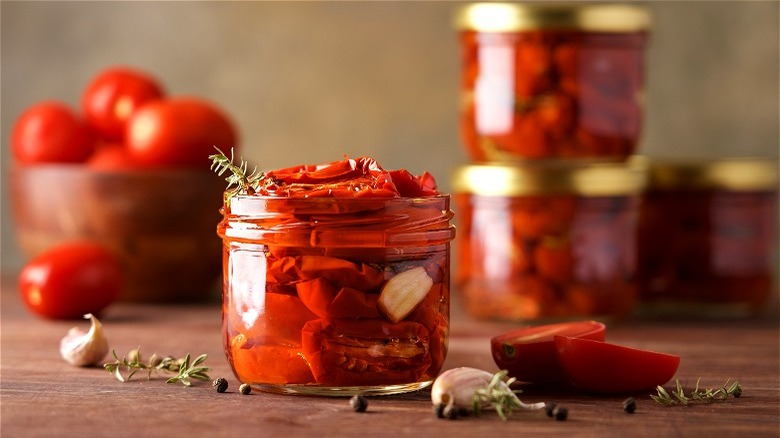The Only 2 Ingredients You Need For Creamy Tomato Sauce In A Pinch
When you think of all of the delicious recipes and dishes you can make with fresh tomatoes, there's a good chance a trusted tomato sauce is a priority. Tomato sauce is one of those staples home chefs use to create a unique savoriness in many favorited recipes. Salted, puréed tomatoes and even tomato paste can accompany various meals and transform recipes' flavor complexity in a pinch. But have tomatoes always had such a domineering force in the culinary world?
Although tomatoes were introduced in Europe by conquerors from Spain in the 16th century, the first-ever tomato sauce recipe wasn't debuted in Italy until 1790. But thanks to modern-day technological advancements and the steady growth of canned tomato products, tomatoes are now one of the most-consumed vegetables in the United States.
Not only are they popular, but among the variety of ways you can chow down on the bright-red fruits, according to AgHires, more than 30% of tomato consumption stems from various tomato sauce products. Whipping up a homemade tomato sauce isn't difficult, however. Among the many recipes out there, sometimes the mood for a creamier sauce strikes, and you need to make a few minor adjustments to your favorite tomato sauce recipe. Surprisingly, you need only two ingredients to make a deliciously creamy tomato sauce, according to Food52: chopped tomatoes and cream cheese. But if you want to take things to the next level, sun-dried tomatoes are the key.
The best ingredients for a quick tomato cream sauce
Among the array of tomato products available on the market, sun-dried tomatoes are one variety that pack a powerful punch of flavor. While you could always use a handful of these conveniently dried veggies to make a sun-dried tomato and Manchego flatbread, you can also use them to craft a delightfully flavorful pasta sauce.
Typically, when you create a tomato sauce at home, the ingredient list is usually small, requiring canned, crushed, or whole tomatoes, garlic, onions, and a few specific spices such as oregano and basil. The downside to simple marinara recipes is the prep and cooking time involved, especially when you're faced with a busy weeknight and in need a of flavorful dish in a snap. And that's not even taking into account the added cream.
Food52 showcases how all you need to create an insanely easy tomato cream sauce is sun-dried tomatoes, cream cheese, and capers. There are no extra steps involved besides finely dicing jarred sun-dried tomatoes and mixing them into four ounces of cream cheese. Once your pasta noodles are cooked, simply add this flavorful cream cheese mixture. (If you're feeling extra adventurous, you can add Food52's fried skillet capers at the end for an added dose of flavor.) Sun-dried tomatoes are packed with so much tangy goodness, why stop at pasta? Sure enough, you can use these flavor-rich tomatoes to enhance a number of your favorite recipes.
Creative ways to use sun-dried tomatoes to level up your meal game
Tomatoes are used in countless dishes due to their signature umami taste. When you eat the sun-dried variety, you're experiencing even more of that umami bite because of those condensed flavors. This makes them not only easy to use, but they also serve as a quick way to brighten up traditional meals.
Sure, you can use these flavorful tomatoes to craft new recipes, such as chicken and wild rice pinwheels. Yet what makes them so convenient is that they require little prep work. If you happen to find your Wednesday night dinner needing an extra kick of flavor, you can always chop up a few and add them in for added depth.
Sun-dried tomatoes serve as a tasty topper to many common dishes, such as baked potatoes, pizza, and omelets. While the oil-packed varieties include a number of different seasonings, dry-packed sun-dried tomatoes can be just as beneficial and they're more affordable. You can also add them to more dishes based on the flavor profile you're after. Cook's Illustrated recommends rehydrating these convenient foods in vegetable broth instead of water to aid in flavor development.


